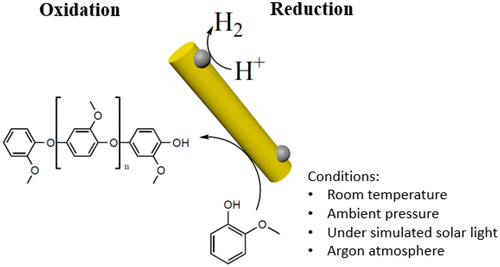当前位置:
X-MOL 学术
›
ACS Appl. Polym. Mater.
›
论文详情
Our official English website, www.x-mol.net, welcomes your
feedback! (Note: you will need to create a separate account there.)
Solar Photocatalytic Phenol Polymerization and Hydrogen Generation for Flocculation of Wastewater Impurities
ACS Applied Polymer Materials ( IF 4.4 ) Pub Date : 2019-06-04 , DOI: 10.1021/acsapm.9b00210 Glenn R Hafenstine 1 , Ryan E Patalano 1 , Alexander W Harris 1 , Grace Jiang 1 , Ke Ma 1 , Andrew P Goodwin 1, 2 , Jennifer N Cha 1, 2
ACS Applied Polymer Materials ( IF 4.4 ) Pub Date : 2019-06-04 , DOI: 10.1021/acsapm.9b00210 Glenn R Hafenstine 1 , Ryan E Patalano 1 , Alexander W Harris 1 , Grace Jiang 1 , Ke Ma 1 , Andrew P Goodwin 1, 2 , Jennifer N Cha 1, 2
Affiliation

|
Achieving global sustainability will require balancing encroaching climate changes while maintaining the existing quality of life. Using sunlight to purify wastewater while simultaneously generating usable fuels is an opportunity to approach both targets in a cost-efficient manner. In addition, converting biomass products to usable polymers is a sustainable approach for potentially replacing polystyrene or other petroleum-derived polymers. Phenols from medical, manufacturing, and agricultural waste are commonly found in many water sources, and they are known to foul common reverse osmosis membranes. Here, we show oxidative polymerization of guaiacol, an aromatic compound derived from biomass, with concurrent hydrogen gas generation by using platinum-seeded cadmium sulfide nanorods (Pt@CdS) as photocatalysts. Rather than forming short oligomers as typically made by enzymes such as laccase and peroxidase, the resulting polymers show higher molecular weights that can more easily flocculate out of water. By comparing guaiacol conversion to molecular weight and dispersity, we found the guaiacol to polymerize via a chain-growth process. We also show that Pt@CdS can polymerize other phenols as well by testing the monomers phenol, 2,6-dihydroxybenzoic acid, gallic acid, and vanillin. Lastly, because the aqueous solubility of these aromatic polymers decreases dramatically with molecular weight, polymerization reactions were also tested in biphasic solutions to determine whether chain growth could propagate in the oil phase. We show that the Pt@CdS nanoparticles can form stable Pickering emulsions in various biphasic combinations and that both H2 formation and polymer molecular weight correlated to the partition coefficient of guaiacol into the oil phase as well as the solubility of the growing polymer chains. These combined studies demonstrate the possibility of using nanoscale photocatalysts to oxidatively polymerize phenolic substrates via a chain-growth mechanism, thereby providing a path for pretreating water by flocculating out contaminants with concurrent generation of hydrogen.
中文翻译:

太阳能光催化苯酚聚合制氢絮凝废水杂质
实现全球可持续性将需要在保持现有生活质量的同时平衡日益严重的气候变化。利用阳光净化废水,同时产生可用燃料是一个以具有成本效益的方式实现这两个目标的机会。此外,将生物质产品转化为可用的聚合物是一种可持续的方法,有可能取代聚苯乙烯或其他石油衍生的聚合物。来自医疗、制造和农业废物的酚类物质普遍存在于许多水源中,众所周知,它们会污染普通的反渗透膜。在这里,我们展示了愈创木酚(一种源自生物质的芳香族化合物)的氧化聚合,并通过使用铂种子硫化镉纳米棒 (Pt@CdS) 作为光催化剂同时产生氢气。与通常由漆酶和过氧化物酶等酶形成的短寡聚物不同,所得聚合物显示出更高的分子量,更容易从水中絮凝出来。通过将愈创木酚转化率与分子量和分散性进行比较,我们发现愈创木酚通过链增长过程进行聚合。我们还通过测试单体苯酚、2,6-二羟基苯甲酸、没食子酸和香兰素表明 Pt@CdS 也可以聚合其他酚类。最后,由于这些芳族聚合物的水溶解度随分子量显着降低,因此还在双相溶液中测试聚合反应以确定链增长是否可以在油相中传播。我们表明 Pt@CdS 纳米粒子可以在各种双相组合中形成稳定的皮克林乳液,并且 H2形成和聚合物分子量与愈创木酚在油相中的分配系数以及增长的聚合物链的溶解度相关。这些综合研究证明了使用纳米级光催化剂通过链增长机制氧化聚合酚类底物的可能性,从而通过絮凝出污染物并同时产生氢气来提供预处理水的途径。
更新日期:2019-06-05
中文翻译:

太阳能光催化苯酚聚合制氢絮凝废水杂质
实现全球可持续性将需要在保持现有生活质量的同时平衡日益严重的气候变化。利用阳光净化废水,同时产生可用燃料是一个以具有成本效益的方式实现这两个目标的机会。此外,将生物质产品转化为可用的聚合物是一种可持续的方法,有可能取代聚苯乙烯或其他石油衍生的聚合物。来自医疗、制造和农业废物的酚类物质普遍存在于许多水源中,众所周知,它们会污染普通的反渗透膜。在这里,我们展示了愈创木酚(一种源自生物质的芳香族化合物)的氧化聚合,并通过使用铂种子硫化镉纳米棒 (Pt@CdS) 作为光催化剂同时产生氢气。与通常由漆酶和过氧化物酶等酶形成的短寡聚物不同,所得聚合物显示出更高的分子量,更容易从水中絮凝出来。通过将愈创木酚转化率与分子量和分散性进行比较,我们发现愈创木酚通过链增长过程进行聚合。我们还通过测试单体苯酚、2,6-二羟基苯甲酸、没食子酸和香兰素表明 Pt@CdS 也可以聚合其他酚类。最后,由于这些芳族聚合物的水溶解度随分子量显着降低,因此还在双相溶液中测试聚合反应以确定链增长是否可以在油相中传播。我们表明 Pt@CdS 纳米粒子可以在各种双相组合中形成稳定的皮克林乳液,并且 H2形成和聚合物分子量与愈创木酚在油相中的分配系数以及增长的聚合物链的溶解度相关。这些综合研究证明了使用纳米级光催化剂通过链增长机制氧化聚合酚类底物的可能性,从而通过絮凝出污染物并同时产生氢气来提供预处理水的途径。































 京公网安备 11010802027423号
京公网安备 11010802027423号